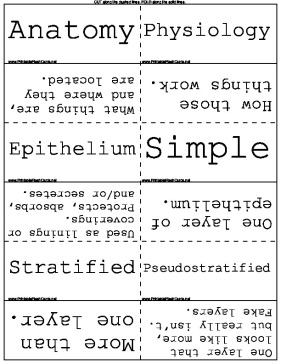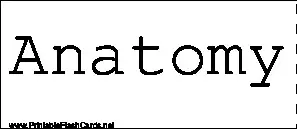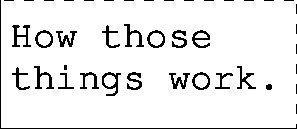

These flash cards are about human physiology and basic anatomy.
There are 105 flash cards in this set (18 pages to print.)
To use:
1. Print out the cards.
2. Cut along the dashed lines.
3. Fold along the solid lines.
Sample flash cards in this set:




| Questions | Answers |
|---|---|
| Anatomy | What things are, and where they are located. |
| Physiology | How those things work. |
| Epithelium | Used as linings or coverings. Protects, absorbs, and/or secretes. |
| Simple | One layer of epithelium. |
| Stratified | More than one layer. |
| Pseudostratified | One layer that looks like more, but really isn't. Fake layers. |
| Transitional | Flexible layer that can stretch. Best identified by having bi nucleated cells. |
| Glandular | Layers found in glands. |
| Squamous | Scale-like shape. |
| Cuboidal | Square-like shape. |
| Columnar | Column-like shape. |
| Tight Junction | Glues and seals gaps between cells. Impermeable. |
| Gap Junction | Open channel between two cells used for communication and intracellular transport. |
| Spot Desmosome | Glues cells together and keeps them anchored. |
| Belt Desmosome | Ropes around cells keeping them together. |
| Cilia | Apical modification. Hairlike projections used for movement. |
| Microvilli | Apical modification used to increase surface area, and/or move things across the surface of the epithelium. |
| Basal Lamina | Bottom layer of cells that separates epithelium from CT. Stains really dark. |
| Keratin | Non-living protein layer used for waterproofing. Stains really dark. |
| Goblet Cell | Also called a gland. Used for secreting - hold mucous. Doesn't stain well. |
| Endocrine | Secretions are released straight into the blood stream. |
| Exocrine | Secretions released into blood via tube/duct systems. |
| Serous | A more water-like secretion. Less thick. |
| Mucous | Thicker secretion. Not as watery. |
| Tubular | Tube-like shaped gland. |
| Alveolar | Sack-like shaped gland, like the alveoli of the lungs. |
| Merocrine | Cell pushes secretions out into duct via vesicles. |
| Holocrine | Cells with secretions are shed into the duct, and then are replaced. |
| Apocrine | Secretion where the portions of cells that have secretions are pinched off into the duct. |
| Lateral | The sides of the cell. |
| Apical | The top of the cell. Can be referred to as vertical also. |
| Basal | The bottom of the cell. |
| Number of Layers | |
| Shape of Layers | |
| Types of Secretions | |
| Secretion Consistancy | |
| Shape of Gland | |
| Function of Gland | |
| Connective Tissue | |
| Matrix | Solidity of connective tissue. |
| Solid | Example of solid matrix: bone. |
| Semi-Solid | Example of semi-solid matrix: cartilage. |
| Fluid | Example of fluid matrix: blood. |
| Fibers | String-like substances found inside the matrix. |
| Collagen | Thick fibers, very strong. |
| Elastic | Thin fibers, very stretchy. |
| Reticular | Cobweb-like fibers. Very thin. |
| Classification of CT | |
| Cartilage | Self explanatory, contains semi-solid matrix. |
| Bone | Self explanatory, contains solid matrix. |
| Blood | Self explanatory, contains fluid matrix. |
| CT Proper | Classification of CT if it doesn't fit into blood, bone, or cartilage. |
| CT Proper | Usually made of fibers, is found between/connects other CT together. |
| Loose Areolar | Has a decent amount of fibers arranged very loosely and randomly. Usually has a lot of white blood cells. |
| Fibroblast | Cells that create fibers. |
| Macrophage | White blood cells that use phagocytosis to fight off invading substances. |
| Mast Cell | Cell that releases chemicals and substances during allergic reactions |
| Adipose | Exactly like loose areolar only it has lots of fat cells in it. |
| Dense Irregular | Lots of collagen fibers, very dense. Fibers go in random directions/entertwine. |
| Dense Regular | Lots of collagen fibers, very dense. Fibers go all in one direction, very uniform. |
| Reticular | Rare type of CT proper. Cobweb-like, provides framework for soft tissue organs. Has lots of reticular fibers. |
| Cartilage | Latin root word for this is chondro. Does interstitial growth, and is avascular. One of the four types of CT. |
| Cartilage Cells | |
| Chondrocyte | Cells that maintain cartilage. |
| Chrondroblast | Cells that create and rebuild cartilage. |
| Perichondrium | Double-layered CT that surrounds cartilage of developing bone. |
| Types of Cartilage | |
| Hyaline | Contains lots of collagen fibers, which are very uniform in pattern. Is usually surrounded by perichondrium. |
| Elastic | Self-explanatory, has lots of elastic fibers. |
| Fibrocartilage | Contains lots of collagen fibers, but unlike hyaline, its arranged in a more loose, spongy fashion. |
| Bone | Latin root word for this is osteo. Bone supports, protects, is used for movement, and makes blood. |
| Types of Bone | |
| Compact Bone | Hard and dense bone that is made up of haversian units. |
| Osteocyte | Bone matrix maintaining cell. |
| Canaliculi | Very small canals that connect lacuna, or rather, osteocytes. |
| Haversian Canal | The big central canal of each haversian unit. |
| Volkmann's Canal | Medium sized canals that connect haversian canals. |
| Lamellae | One layer of bone/solid matrix. |
| Circumferential | Round rings of lamellae. |
| Interstitial | Straight lines/rows of lamellae. |
| Spongy Bone | The spongy looking stuff inside bone. Contains red bone marrow in the epiphysis, yellow in the diaphysis. Also called cancellous bone. |
| Trabeculae | The rough part of spongy bone that forms the holes in which bone marrow is found. |
| Parts of a Bone | |
| Periosteum | Outer layer of bone. |
| Endosteum | Inside layer of bone |
| Diaphysis | Skinny shaft of bone. Contains yellow bone marrow. |
| Epiphysis | Ends of bones. Contains red bone marrow. |
| Bone Developement | |
| Osteogenesis | Beginning of (creating) bone. |
| Osteoblast | Creates and rebuilds bone matrix. Will become an osteocyte when trapped. |
| Osteoclast | Kills or destroys bone matrix. Frees trapped osteocytes. |
| Osteocyte | Maintains bone matrix, and gets stuck in the lacuna. |
| Endochondrial Ossification | Forms most bones, mostly long bones. Replaces cartilage from the inside out. |
| Bone Collar | A supporting model that helps the bone keep its shape as it grows, kind of like a mold. Also called periosteal bone. |
| Epiphyseal Line | Cartilage between the primary and secondary ossification centers. Also called the growth plate. |
| Intramembranous Ossification | Forms flat bones, such as the top of the skull. Bone are formed in sheet like layers. |
| Fontanels | Soft spots where bone has not yet been created or is still in the process of being created. |
| Important Other Words | |
| Lacuna | Holes in matrix where cells are found, such as osteocytes. |
| Interstitial Growth | Grows from within - like inside out. |
| Hydroxyapatite | Calcium phosphite |
| Yellow Marrow | More fatty. Inactive marrow, but will make blood cells in emergencies. |
| Red Marrow | Active marrow that continually makes red and white blood cells. |
| Avascular | Containing no veins or blood vessels. |
| EXTRA | In case I get more words and I need to write them down. |